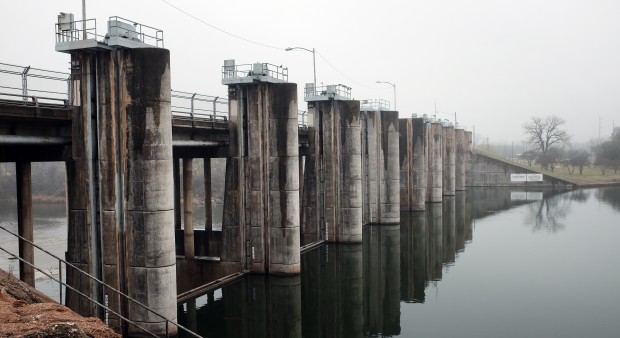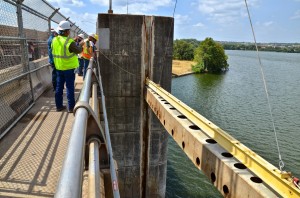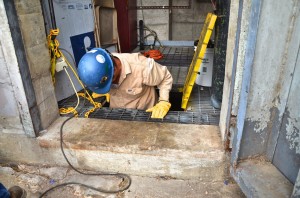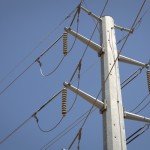This Dam Holds in Lady Bird Lake, So When Will It Get ‘Essential’ Repairs?
The poor condition of the dam that holds in the waters of Austin’s beloved Lady Bird Lake continues to vex city officials. Emails obtained in a public information request reveal challenges the city faced in performing maintenance on Longhorn Dam, which crosses the Colorado River beneath Pleasant Valley Road. Documents tell of water lost through the dam’s gates that could potentially stay in upstream reservoirs, and show city departments struggling to assign responsibility for the structure and plan a long-term solution.
Austin Energy, the city-owned electric utility, and the Lower Colorado River Authority (LCRA) have long known about the need for work on the dam. Austin Energy is the city department that operates the structure. The LCRA operates dams upstream from Austin and coordinates with Austin Energy when they release water downstream.
The Dam
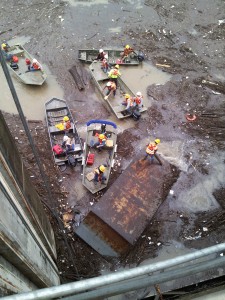
Photo Courtesy of Austin Energy.
Crews work to dislodge a barge from Longhorn Dam in Lady Bird Lake on Halloween 2013.
There are nine gates on Longhorn Dam that can allow water to pass. One of the seven “lift gates” that are manually opened and closed to control flooding has been broken for years. The difficulty of manually opening those gates during storms has been responsible for some flooding along the hike and bike trail and occasional drops in lake levels according to city documents.
Many challenges at the dam are baked into its history. Built in 1960 to create a reservoir for the Holly Power Plant, it was initially intended to help with electricity generation. That reservoir is what is known today as Lady Bird Lake. The power plant is gone, but the dam is relied on to maintain water levels in the lake. It also helps control water releases downstream, a function that’s become more important as the region remains in a years-long drought.
Problems at the dam gained wider attention after the Halloween Flood in 2013. Operations during that storm, including an incident when a barge jammed into one of the gates, caused what one city staffer described as a near “catastrophe.” At one point, Lady Bird Lake started to “empty out.”
A Hot Potato
After the flood in 2013, city officials circulated a draft memo proposing that Austin Energy give up control of the structure. The electric utility has little reason to operate a dam without a power plant, and the prospect of repairs and upkeep were daunting. “Historically they have just been doing the bare minimum to keep it operational,” Austin Energy employee Kathleen Garrett wrote in an email several weeks before the October flood.
Under the proposal, the City of Austin would take over responsibility for the structure. In exchange, Austin Energy would give valuable land around the old Holly Power Plant and at Justin Lane to the Austin Parks Department. The properties were valued at around $30 million in 2013.
But taking control of the dam would be an expensive headache. An email from Austin Energy’s Chief Operating Officer Cheryl Mele to Assistant City Manager Robert Goode explained that “the mechanical, electrical, and hydraulic systems need replacements within the next few years. One option is to replace most of the major control systems components including the flood gates. the other is to replace the gated dam altogether (…)”
The initial engineering and construction cost of fixing the gates was put at $10,600,000 with expenses raising as high at $20 Million. A full replacement with a different kind of structure was pegged at $16,500,000.
By April 2014 the plan to trade the dam for real estate appeared to be off the table. Assistant City Manager Robert Goode ran through other options with heads of Austin Water and Austin Energy. One was to have the electric utility fix the dam and then let the water utility take control. Another was to issue bonds so that the water utility could fix the dam and take it over.
Losing Water In A Drought
While the City was deciding who might take control of the dam, the way the it releases water had caught the attention of the City of Austin Water Resource Planning Task Force, a group convened by the city to plan for Austin’s future water needs.
Austin’s Lady Bird Lake is maintained at a constant lake level. When the lake falls below that level, the LCRA sometimes releases water from upstream reservoirs to make up the difference. Those releases can draw down Austin’s municipal water supply in Lake Travis. In that way, the unnecessary release of water from Longhorn Dam can impact Austin’s depleted upstream reservoirs.
In its list of recommendations to City Council, the Task Force suggested repairs and improved management of the dam’s flood gates to better control water flows. The recommendations could save up to 4,000 acre-feet of water a year, according to the Task Force. The City of Austin used approximately 142,000 acres feet of water in 2013.In July 2014, Austin Energy and the LCRA scheduled a meeting to discuss work on the dam and better control of the flow of water. The group also planned to address how to improve dam operations during storms. During one 2014 storm “operations required LCRA to release several hundred acre-feet of water to raise the level of Lady Bird Lake after the storm had passed,” wrote the LCRA’s David Walker, adding “this was the second incident so far this year.”
Reducing the amount of water lost through the gates requires better coordination with LCRA and work on the dam’s lift gates, according to the task force recommendations. Austin Energy and the water utility says coordination has improved but no work has been done to the lift gate.
When asked whether any water savings could be shown from the work done in 2014, Austin Energy spokesperson Robert Cullick said “No, I don’t think anyone has been charged with the responsibility.”
Problems at the dam have also caught the attention of Austin’s Watershed Protection Department. In July, Department head Victoria Li asked staff to comb through Austin’s Corporate Capital Improvement plan for an indication that the dam would be repaired. She also commissioned her own report on the structure. “I just want to make sure that City is going to fix the dam in the near future…” she wrote.
What Has Been Done
Some repairs were in the works. On August 18th, the city started a project to repair the hydraulic pumps that help operate the dam’s “bascule gates.” Those gates automatically release water from the lake. Other “lift gates” on the dam are raised and closed manually for flood control.
The initial phase of the project was expected to take about a month. Documents suggest it ran at least a month over schedule. The major hold up was the need to reverse engineer parts of the dam. “The equipment is fifty years old, and hasn’t been worked on for twenty years,” Austin Energy Engineer Gerald Bocian wrote to the City Transportation Department to explain the delay.
Large blocks used to hold back water called “stop logs” also presented problems. For years the city has kept a stop log in front of a completely broken lift gate at the dam. Austin Energy did not plan on repairing that gate, but removed the stop log to use it in work on it a different gate and found the stop log itself was in need of repairs. Leaks from the stop logs posed a challenge. “Hopefully the wood seals will swell and seal up,” Boscian wrote. “If not I will get the divers back out, and stuff plastic bags into the cracks to stop the leaks.”
After numerous interview requests with various city departments including Austin Energy, the city’s Watershed Protections Department and Austin Water, Austin Energy made spokesperson Robert Cullick available for an interview. Cullick says improvisations like the use of plastic bags are not uncommon during repair work.
He said on other dam repair jobs he’s seen people use corn to seal leaks. “You drop horse corn in and it gets sucked in where the gap is,” he said. “It’s hominy. So it swells and it fills the gap. It’s not a matter of the structure of the dam, or a vast amount of water.”
Cullick says the measure was temporary. But the challenges officials encountered in repairing the hydraulics and stop logs suggest that larger repairs could be a daunting task.
The Work that Remains
The work that started in August cost about $650,000. That’s a far cry from the $10 million price tag for initial gate repairs quoted by Austin Energy in 2013. Not surprisingly, it left many concerns unanswered.
For one, the “lift gates” that control lake levels in times of floods still need repairs. One of the gates is completely inoperable, others “have failed to open or close properly” according to a review by the Austin Watershed Protection Departments Value Engineering team. “This is reportedly an inherent problem with the type of hoists at Longhorn Dam,” says the report.
The report cites six instances where problems with the gates have affected lake levels in the last dozen years. In some cases the gates drained too much of the lake. In others, the gates contributed to flooding in areas along Austin’s hike and bike trail. That areas exists in a flood zone, so one of the questions city planners are grappling with is this how much fluctuation in lake levels is acceptable. and how much money is worth spending to better stabilize lake levels.
In public statements Austin Energy says there is no rush. The utility says it has no plans to spend more money on repairs until responsibility for management of the dam is transferred to a different department.
“[Fixing the flood gates] is always on the list of city priorities,” said Cullick. “It hasn’t been in a place where its more important than say taking the houses in the Onion Creek flood plain out of harms way.”
But that notion that there is little urgency appears to conflict with internal emails. Those suggest the full scope of repairs should be undertaken “in the near future” or “within a few years.”
“While the risk of imminent failure is not high, an increased sense of urgency should be applied to a study process that has already spanned 4 years,” reported the review by the city’s Watershed Protection Department last summer. “Without significant repairs to the existing dam, the severity of lake level fluctuations can only get worse.”
Public information staff with the City of Austin Watershed Protection Department, LCRA and Austin Water rebuffed interview requests. After saying engineering staff would be available for comment, Austin Energy spokesperson Robert Cullick was the only staffer who was made available for an interview.
